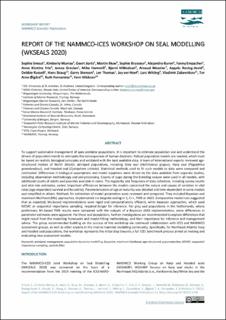| dc.description.abstract | To support sustainable management of apex predator populations, it is important to estimate population size and understand the drivers of population trends to anticipate the consequences of human decisions. Robust population models are needed, which must be based on realistic biological principles and validated with the best available data. A team of international experts reviewed age-structured models of North Atlantic pinniped populations, including Grey seal (Halichoerus grypus), Harp seal (Pagophilus groenlandicus), and Hooded seal (Cystophora cristata). Statistical methods used to fit such models to data were compared and contrasted. Differences in biological assumptions and model equations were driven by the data available from separate studies, including observation methodology and pre-processing. Counts of pups during the breeding season were used in all models, with additional counts of adults and juveniles available in some. The regularity and frequency of data collection, including survey counts and vital rate estimates, varied. Important differences between the models concerned the nature and causes of variation in vital rates (age-dependent survival and fecundity). Parameterisation of age at maturity was detailed and time-dependent in some models and simplified in others. Methods for estimation of model parameters were reviewed and compared. They included Bayesian and maximum likelihood (ML) approaches, implemented via bespoke coding in C, C++, TMB or JAGS. Comparative model runs suggested that as expected, ML-based implementations were rapid and computationally efficient, while Bayesian approaches, which used MCMC or sequential importance sampling, required longer for inference. For grey seal populations in the Netherlands, where preliminary ML-based TMB results were compared with the outputs of a Bayesian JAGS implementation, some differences in parameter estimates were apparent. For these seal populations, further investigations are recommended to explore differences that might result from the modelling framework and model-fitting methodology, and their importance for inference and management advice. The group recommended building on the success of this workshop via continued collaboration with ICES and NAMMCO assessment groups, as well as other experts in the marine mammal modelling community. Specifically, for Northeast Atlantic harp and hooded seal populations, the workshop represents the initial step towards a full ICES benchmark process aimed at revising and evaluating new assessment models. | en_US |

